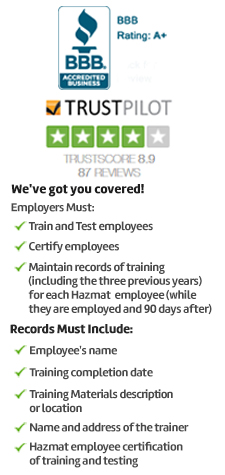
OSHA Shipyard/Maritime Chemical Hazards

Workers associated with Maritime and shipyard industry are exposed to various toxic chemicals and hazardous substances. This online course focuses on chemical hazards and toxic substances workers in shipyards and Maritime industry have to negotiate as part of their daily work routine.
The course follows OSHA regulated safety standards and training principles and addresses responsibilities of workplace managers, workers and employers. Participants are educated about the nature of chemical hazards, types, hazard control exercises, federal laws and safety standards to control these hazards.
Governing regulations
OSHA has drawn certain regulations which are applicable to industries dealing with chemical hazards and toxic substances:
29 CFR 1915 – Shipyard; 29 CFR 1915 Subpart Z – Toxic and Hazardous Substances; 29 CFR 1917 – Marine Terminals; 29 CFR 1917.22-25 – Hazardous Cargo; 29 CFR 1917.28 – Hazard Communication; 29 CFR 1917.152-153 – Welding, Cutting, and Heating; 29 CFR 1918 – Longshoring; 29 CFR 1918.90 – Hazard Communication; 29 CFR 1918.93 – Hazardous Atmospheres and Substances; 29 CFR 1918.94 – Ventilation and Atmospheric Conditions.
Course Overview
This online safety course offers basic safety training to participants about toxic substances and chemical hazards present in the maritime industry. Students get to know the compliance procedures for employers and responsibilities for workers, kinds of health hazards due to dangerous chemicals and toxic substances, how to control hazards and safety regulations to contain risks and dangers at workplaces. The course has been made to provide greater understanding with regard to chemical hazards in Shipyard/maritime industrial work environments, how to safeguard one from such hazards, training procedures, and safe practices. The course will cover some of the most common chemical hazards and toxic items exist at workplaces such as asbestos, lead and chromium.
Who Must Take this Course?
As employers are responsible for workers’ safety, it is important the enterprises educate their workers about the impending dangers, hazards and operational risks in their daily work schedules or assigned works. Hence all employees who face such hazards on a daily basis or when assigned to work at risk-filled environments, must take this online safety course to know how to manage risks and hazards and also to enhance their career prospects.
Course Format
Our online OSHA training course to address Chemical Hazards & Toxic Substances in Maritime/Shipyard Industry will provide students expert-prepared content, important case studies, graphical and audio clippings and self-test questions to get best results in the final exam.
Upon completion of the course successfully each participant will get a Hard copy of certificate and a wallet card.
Continuing education credits?
Each candidate will be receiving 0.2 CEUs (or 2 CMEs) after the completion of the course.
Topics Covered
- Introduction to Maritime Chemical Hazards and Toxic Substances
- Types of Health Hazards
- Toxicology
- Routes of Entry
- Special Considerations for the Maritime Industry
- Key Terms
- Regulations and Standards
- State Regulations
- International Maritime Dangerous Goods Code (IMDG)
- Responsibilities-Employers
- Responsibilities-Employees
- Training
- Competent Person
- Hazard Awareness
- Recognition of Health Hazards
- Common Health Effects of Chemical Hazards
- Employee Exposure and Medical Records
- Hazard Monitoring
- Hazard Communication Standard
- Occupational Exposure Limits (OELs)
- Safety Data Sheets
- Labels
- Hazard Communication Program
- Exposure Controls
- Elimination/Substitution
- Engineering Controls
- Ventilation
- Administrative and Work Practice Controls
- Personal Protective Equipment
- Respiratory Protection
- Selecting Respiratory Protection
- Respirator Components
- Types of Respirators
- Respiratory Protection Program
- Maritime Industry Chemicals and Toxic Substances
- Gases
- Gas Properties
- Common Hazardous Gases
- Vapors
- Common Hazardous Vapors in Shipyards and Marine Terminals
- Fumes
- Common Hazardous Fumes in Shipyards and Marine Terminals
- Dusts
- Dust in Shipyards and Marine Terminals
- Mists
- Common Mists in Shipyards and Marine Terminals
- Asbestos
- Asbestos Classification
- Asbestos Employer Requirements
- Lead
- Lead Exposure Levels
- Lead-Medical Surveillance
- Hexavalent Chromium
- Cadmium
- Summary
- Additional Resources
- Exam

 NEBOSH CERTIFICATE
NEBOSH CERTIFICATE NEBOSH DIPLOMA
NEBOSH DIPLOMA IOSH
IOSH SAFETY DIPLOMA
SAFETY DIPLOMA CPD UK
CPD UK ROSPA UK
ROSPA UK FOOD SAFETY
FOOD SAFETY 



